Took some time but I found a solution based on examples and discussion provided by two authors, their contributions can be found here:
https://gist.github.com/davidliu/c246a717f00494a6ad237a592a3cea4f
https://github.com/gavingt/BottomSheetTest
The basic logic is to handle touch events in onInterceptTouchEvent in a custom BottomSheetBehavior and check in a CoordinatorLayout if the given view (from now on named proxy view) is of interest for the rest of the touch delegation in isPointInChildBounds.
This can be adapted to use more than one proxy view if needed, the only change necessary for this is to make a proxy view list and iterate the list instead of using a single proxy view reference.
Below follows the code example of this implementation. Do note that this is only configured to handle vertical movements, if horizontal movements are necessary then adapt the code to your need.
activity_main.xml
<?xml version="1.0" encoding="utf-8"?>
<com.example.tabsheet.CustomCoordinatorLayout
xmlns:android="http://schemas.android.com/apk/res/android"
xmlns:app="http://schemas.android.com/apk/res-auto"
xmlns:tools="http://schemas.android.com/tools"
android:id="@+id/customCoordinatorLayout"
android:layout_width="match_parent"
android:layout_height="match_parent"
tools:context=".MainActivity">
<com.google.android.material.tabs.TabLayout
android:id="@+id/tabLayout"
android:layout_width="match_parent"
android:layout_height="wrap_content"
android:layout_gravity="bottom"
android:background="@android:color/darker_gray">
<com.google.android.material.tabs.TabItem
android:layout_width="wrap_content"
android:layout_height="wrap_content"
android:icon="@drawable/ic_launcher_background"
android:text="Tab 1" />
<com.google.android.material.tabs.TabItem
android:layout_width="wrap_content"
android:layout_height="wrap_content"
android:icon="@drawable/ic_launcher_background"
android:text="Tab 2" />
<com.google.android.material.tabs.TabItem
android:layout_width="wrap_content"
android:layout_height="wrap_content"
android:icon="@drawable/ic_launcher_background"
android:text="Tab 3" />
<com.google.android.material.tabs.TabItem
android:layout_width="wrap_content"
android:layout_height="wrap_content"
android:icon="@drawable/ic_launcher_background"
android:text="Tab 4" />
<com.google.android.material.tabs.TabItem
android:layout_width="wrap_content"
android:layout_height="wrap_content"
android:icon="@drawable/ic_launcher_background"
android:text="Tab 5" />
</com.google.android.material.tabs.TabLayout>
<androidx.coordinatorlayout.widget.CoordinatorLayout
android:id="@+id/bottomSheet"
android:layout_width="match_parent"
android:layout_height="match_parent"
android:background="#3F51B5"
android:clipToPadding="false"
app:behavior_peekHeight="0dp"
app:layout_behavior=".CustomBottomSheetBehavior" />
</com.example.tabsheet.CustomCoordinatorLayout>
MainActivity.java
public class MainActivity extends AppCompatActivity {
@Override
protected void onCreate(Bundle savedInstanceState) {
final CustomCoordinatorLayout customCoordinatorLayout;
final CoordinatorLayout bottomSheet;
final TabLayout tabLayout;
super.onCreate(savedInstanceState);
setContentView(R.layout.activity_main);
customCoordinatorLayout = findViewById(R.id.customCoordinatorLayout);
bottomSheet = findViewById(R.id.bottomSheet);
tabLayout = findViewById(R.id.tabLayout);
iniList(bottomSheet);
customCoordinatorLayout.setProxyView(tabLayout);
}
private void iniList(final ViewGroup parent) {
@ColorInt int backgroundColor;
final int padding;
final int maxItems;
final float density;
final NestedScrollView nestedScrollView;
final LinearLayout linearLayout;
final ColorDrawable dividerDrawable;
int i;
TextView textView;
ViewGroup.LayoutParams layoutParams;
density = Resources.getSystem().getDisplayMetrics().density;
padding = (int) (20 * density);
maxItems = 50;
backgroundColor = ContextCompat.getColor(this, android.R.color.holo_blue_bright);
dividerDrawable = new ColorDrawable(Color.WHITE);
layoutParams = new ViewGroup.LayoutParams(
ViewGroup.LayoutParams.MATCH_PARENT,
ViewGroup.LayoutParams.MATCH_PARENT
);
nestedScrollView = new NestedScrollView(this);
nestedScrollView.setLayoutParams(layoutParams);
nestedScrollView.setClipToPadding(false);
nestedScrollView.setBackgroundColor(backgroundColor);
linearLayout = new LinearLayout(this);
linearLayout.setLayoutParams(layoutParams);
linearLayout.setOrientation(LinearLayout.VERTICAL);
linearLayout.setShowDividers(LinearLayout.SHOW_DIVIDER_MIDDLE);
linearLayout.setDividerDrawable(dividerDrawable);
for (i = 0; i < maxItems; i++) {
textView = new TextView(this);
textView.setText("Item " + (1 + i));
textView.setPadding(padding, padding, padding, padding);
linearLayout.addView(textView, layoutParams);
}
nestedScrollView.addView(linearLayout);
parent.addView(nestedScrollView);
}
}
CustomCoordinatorLayout.java
public class CustomCoordinatorLayout extends CoordinatorLayout {
private View proxyView;
public CustomCoordinatorLayout(@NonNull Context context) {
super(context);
}
public CustomCoordinatorLayout(
@NonNull Context context,
@Nullable AttributeSet attrs
) {
super(context, attrs);
}
public CustomCoordinatorLayout(
@NonNull Context context,
@Nullable AttributeSet attrs,
int defStyleAttr
) {
super(context, attrs, defStyleAttr);
}
@Override
public boolean isPointInChildBounds(
@NonNull View child,
int x,
int y
) {
if (super.isPointInChildBounds(child, x, y)) {
return true;
}
// we want to intercept touch events if they are
// within the proxy view bounds, for this reason
// we instruct the coordinator layout to check
// if this is true and let the touch delegation
// respond to that result
if (proxyView != null) {
return super.isPointInChildBounds(proxyView, x, y);
}
return false;
}
// for this example we are only interested in intercepting
// touch events for a single view, if more are needed use
// a List<View> viewList instead and iterate in
// isPointInChildBounds
public void setProxyView(View proxyView) {
this.proxyView = proxyView;
}
}
CustomBottomSheetBehavior.java
public class CustomBottomSheetBehavior<V extends View> extends BottomSheetBehavior<V> {
// we'll use the device's touch slop value to find out when a tap
// becomes a scroll by checking how far the finger moved to be
// considered a scroll. if the finger moves more than the touch
// slop then it's a scroll, otherwise it is just a tap and we
// ignore the touch events
private int touchSlop;
private float initialY;
private boolean ignoreUntilClose;
public CustomBottomSheetBehavior(
@NonNull Context context,
@Nullable AttributeSet attrs
) {
super(context, attrs);
touchSlop = ViewConfiguration.get(context).getScaledTouchSlop();
}
@Override
public boolean onInterceptTouchEvent(
@NonNull CoordinatorLayout parent,
@NonNull V child,
@NonNull MotionEvent event
) {
// touch events are ignored if the bottom sheet is already
// open and we save that state for further processing
if (getState() == STATE_EXPANDED) {
ignoreUntilClose = true;
return super.onInterceptTouchEvent(parent, child, event);
}
switch (event.getAction()) {
// this is the first event we want to begin observing
// so we set the initial value for further processing
// as a positive value to make things easier
case MotionEvent.ACTION_DOWN:
initialY = Math.abs(event.getRawY());
return super.onInterceptTouchEvent(parent, child, event);
// if the last bottom sheet state was not open then
// we check if the current finger movement has exceed
// the touch slop in which case we return true to tell
// the system we are consuming the touch event
// otherwise we let the default handling behavior
// since we don't care about the direction of the
// movement we ensure its difference is a positive
// integer to simplify the condition check
case MotionEvent.ACTION_MOVE:
return !ignoreUntilClose
&& Math.abs(initialY - Math.abs(event.getRawY())) > touchSlop
|| super.onInterceptTouchEvent(parent, child, event);
// once the tap or movement is completed we reset
// the initial values to restore normal behavior
case MotionEvent.ACTION_UP:
case MotionEvent.ACTION_CANCEL:
initialY = 0;
ignoreUntilClose = false;
return super.onInterceptTouchEvent(parent, child, event);
}
return super.onInterceptTouchEvent(parent, child, event);
}
}
Result with transparent status bar and navigation bar to help visualize the bottom sheet sliding up, but excluded from the code above since it was not relevant for this question.
Note: It is possible you might not even need a custom bottom sheet behavior if your bottom sheet layout contains a certain scrollable view type (NestedScrollView for example) that can be used as is by the CoordinatorLayout, so try without the custom bottom sheet behavior once your layout is ready since it will make this simpler.


